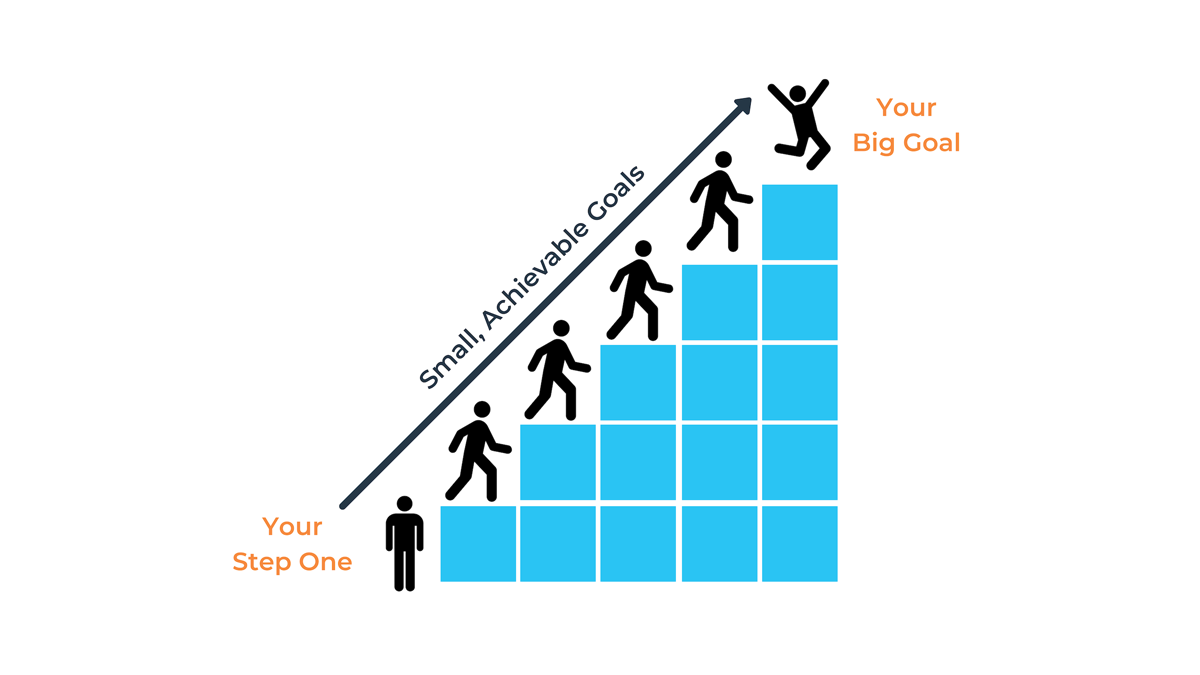It's no small undertaking when you choose to consciously improve your health and making the decision to change is just the first step. SMART goals empower you to build habits that last; the end goal isn't perfection, but to cultivate sustainable and attainable health for yourself.
How to Build Healthy Habits That Last
We all have different reasons we desire to build better habits, motivated by things like wanting to lose weight, drink more water, or manage underlying symptoms of chronic disease.
Wherever you're at in your health journey, remember that setting goals and creating healthy habits takes strategy and dedication, along with a lot of self-love and patience.
Health isn’t a destination, it's a journey. What's that saying, "Rome wasn't built in a day" and "everybody starts somewhere"; this is a process and all that matters right now is your commitment to yourself and how you feel.
People often struggle at achieving their health goals when they set goals that are too big, too broad, or lack a solid plan, undermining their efforts and leading to feelings of defeat, struggling with their relationship with food, yo-yo dieting, and unfortunately seeing no improvements in their health.
Being unsure of your motivation leads to unrealistic goal setting or goals that are not aligned with your internal values, making them more difficult or nearly impossible to achieve. Identifying what you value about new habits can help prevent you from failing completely at behavior change.
That being said, there’s nothing wrong with failure or struggling, in fact, it helps us learn, and without failures or losses, we probably would never be motivated to do anything. Often we figure out what we want by knowing what we don’t want, this is the ebb and flow of your own unique health journey.
If you struggle with sticking to your goals, try approaching your health with more curiosity and ask yourself why is your health important to you. What makes taking action important to you? Then list out goals that feel aligned with what the best version of you looks like.
Whether it's one day or day one, transforming your health starts with what's on your plate, and we are serving up nourishing meals to help you build habits that last. Let us help you conquer your goals.
Why Goal Setting Is Important
Clear goals give us a finish line - something to work towards and a general direction. Goals can also serve as a way to reinforce desirable behaviors and increase motivation.
When you first attempt a new diet, workout routine, or behavior change, you probably have a pretty big goal in mind or maybe your healthcare physician, health coach, or dietitian has recommended several changes to your lifestyle.
As you're standing on the horizon of your new big goal it can start to feel overwhelming fairly quickly - maybe a little exciting too - but mostly overwhelming when you start to realize how many steps you've got to take to reach your goal and how long this process might actually take. This in itself can defeat a lot of people when they start to realize it.
Large goals may provide a direction, but they don't always give a clear map of your journey. And often there are no established rewards along the way to help keep you motivated.
When crafting your health goals think through a few key questions:
- How do I want to feel in 6 months? A year?
- What steps do I need to take to achieve that?
- When have I tried to do something like this in the past and how successful was I?
- Where might I struggle? Where might I easily succeed?
- What tools or external things do I need to help me?
- How do I see myself achieving that?
Learning how to create SMART goals can help set tangible goals and objectives, whether they are short-term goals (daily, weekly, monthly) or long-term goals (6-12 months), when it comes to changing unwanted habits or cultivating a healthier lifestyle.
What Do SMART Goals Stand For?
A SMART goal is an acronym used to plan goals that are "specific", "measurable", "attainable", "relevant" (or realistic), and "time-bound".

- Specific - Create a clear specific goal describing the outcome and target an area for improvement. Having vague goals doesn't provide you the direction you need to be successful, get as specific as possible. A specific goal should answer the, "who, what, when, where, and why"
- Non-Specific goal: "I want to lose weight"
- Specific goal: "I will start walking for 30 minutes on the treadmill, 3 days a week (Monday, Tuesdays, and Saturdays) to improve my health and energy levels"
- Measurable - This is the way you will measure your progress and reevaluate your goal, the "how" of your goal, using some sort of metric to document progress or confirm that your goal was achieved.
- Attainable - Set an achievable goal that you can reasonably accomplish within a timeframe. Start with small but achievable goals that are easily outlined into specific steps, letting you meet your smaller goals, working up to larger ones that may be more difficult to achieve.
- Relevant - Be realistic with yourself, and create a smart goal that aligns with your values and long-term vision of health.
- Time-Bound - Make sure your goal has a start and end date. You want to create real-time-based parameters for yourself.
How to Write a SMART Goal
Visualize the big picture and start to break it down into achievable steps using the SMART goal structure.
You can also work with your health care provider, health coach, or dietician to refine and hone in on specific health goals such as an appropriate amount of weight loss to improve your health or integrating a nutrition plan.
Step 1: Be Specific and Write Down Your Goals
The first step in creating a sustainable habit is to be specific about your goal, taking any broad statements that could be approached in various ways and making them more specific by outlining how it could be set as a goal.
The trick to setting smart goals that you are more likely to achieve is to think smaller. Small changes are easier to make and can lead to big results if you stick with it. Steps become miles and miles become marathons. You can keep your big goal, but use small, incremental goals to break it up into a more realistic road map.

Smaller, incremental goals can also help keep you motivated because you are more likely to achieve them. And crushing your smart goals feels pretty damn good - releasing dopamine, establishing positive reinforcement, and helping you feel unstoppable.
Keep in mind that setting a goal like losing a certain amount of weight or eating a defined amount of calories per day may be specific, but not realistic; setting a specific behavioral smart goal is a more compassionate approach that can include specific dietary changes or changes to your movement routine.
- Example of a broad goal: "I want to lose weight"
- Example of a specific behavioral goal: "I will increase my daily activity by stationary biking"
Goal setting tip: write down your goals.
Don't just think about what smart goals you want to achieve, physically write them down somewhere. The act of putting it on paper (or in your computer/phone) can actually strengthen your commitment to it. And checking off your smart goals when you hit them is super satisfying.
Step 2: Determine How To Measure Your Success or Track Your Progress
Once you set your specific smart goal, now define how you will track your progress or measure your success with the smart goal.
- Example: "I would like to increase my daily activity from walking once a week to stationary biking for 30 minutes, three days a week (Monday, Tuesday, and Saturday) from 10:00 - 10:30 AM".
Your broad vision can still be weight loss or increasing your physical activity, but defining specific parameters around things like time spent, specific days, etc. will help you track your success at completing the specific action.
Maybe you need to download an app, buy a new calendar, or utilize your calendar or notes on your phone to help you plan ahead.
Step 3: Make Your SMART Goal Achievable and Prepare For Obstacles
Setting a goal that is achievable and attainable also means thinking through potential obstacles and asking yourself if you have all the tools and skills you need to succeed.
Ask yourself, what do I need to complete this goal? Maybe there are things you need to address first and create goals around those points, like lack of time, no access to a gym, friends who sabotage you, a work environment that promotes unhealthy behavior, or lack of reliable information.
You can note these potential pitfalls and plan for ways around them and then create a goal that is more attainable:
- Example of a goal without attainable criteria: "I haven't worked out in over two years, but I am going to start biking for five days a week".
- Example of an achievable goal: "I would like to start working out again and am going to start first by biking for 2-3 days a week for 30 minutes, on Mondays, Tuesdays, and Saturdays".
Not only are you breaking down your goal into smaller steps, but you're also outlining measurable checkpoints and identifying specific things you'll need to complete your goal.

If you get stuck, take a few steps back, to re-evaluate your goal and know that this is completely normal!
Ask yourself, how could I do this better? Or think of a time in the past when you have overcome an obstacle or adopted a new behavior you enjoyed. How were you able to overcome the challenge in the past? What tools and character strengths did you use in the past that you could use now?
One of the best ways to build a suistainable habits is to start with a tiny habit and be consistent!
Step 4: Set a Time-Frame and Check-in's
Remember the SMART goal structure; specific, measurable, achievable, realistic, and time-bound.
Once you've outlined your specific goal, how you will measure it, and a realistic plan around it, ask yourself about the time frame you'd like to achieve your goal.
For example, going from not working out at all to working out 3 days a week may be too big of a start. Try taking a walk for 1 day a week for 2 weeks, then increase it to 2, then 3, and so on.
Or if you're broad goal is to lose 10 lbs in a year, then your smaller goal may be to increase your physical activity to 5 days a week within 6 months.
Don't forget to keep track of how far you've come and how things are going with progress photos, journaling, social media updates, etc. This allows you to look back and see what you've accomplished, even if you haven't hit every single goal. Can you visually see a change?
How do you feel physically and mentally? What other ways can you measure how well you are doing overall?
Consistency is key when it comes to sticking to a new habit or routine and keeping track will help you identify where you may be inconsistent or falling short.
Step 5: Reward Yourself
Incentivize yourself with mini rewards as you hit certain milestones or conquer your smaller goals. Creating a series of wins is a great way to stay motivated and can make the journey that much more enjoyable.
Some great, healthy ways to pat yourself on the back include:
- Post it on social media
- Look in the mirror and tell yourself how awesome you are
- Take a day off to relax and rejuvenate
- Buy yourself a new set of workout clothes
- Take yourself out to dinner or a movie
Step 6: Know that You Can Always Start Over
If at first, you don't succeed... try it again. Know that you can always give yourself a fresh start, no matter what. Don't let failure hold you back from ultimately being successful. Failure is your opportunity to learn and grow, and just get better at making healthy decisions.
Even if you really go off the deep in, take comfort in the fact that you can create a fresh, clean slate at any time.
Building Healthy Habits
Building healthy habits takes time and consistency, but you aren't alone in your journey. Check out these other resources to help you create sustainable wellness:
- How to Break Bad Habits
- 25 Healthy Habits Anyone Can Start
- How to Stop Eating Junk Food
- Conquering Stress Eating
- Overcoming Sugar Cravings
- How to Stay Motivated to Workout
Ready to set nutrition-based health goals?
Consider opting for a meal delivery program, like Trifecta, that cooks, and ships all your food right to your door - cutting out a lot of the hard work when it comes to your food and helping you stay more consistent.



